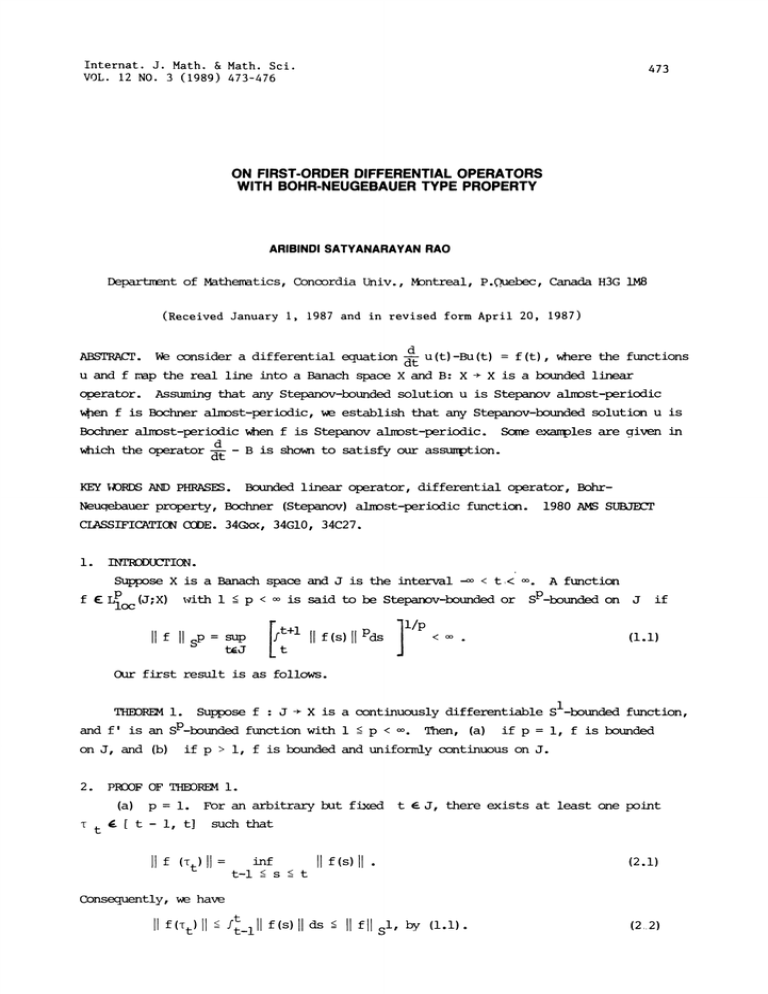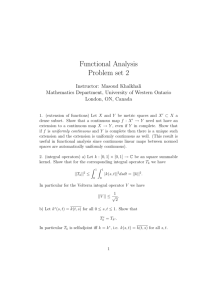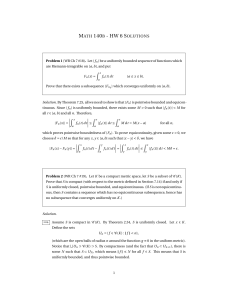Document 10438083
advertisement

Internat. J. Math. & Math. Sci.
VOL. 12 NO. 3 (1989) 473-476
473
ON FIRST-ORDER DIFFERENTIAL OPERATORS
WITH BOHR-NEUGEBAUER TYPE PROPERTY
ARIBINDI SATYANARAYAN RAO
Department of Mathenmtics, Conoordia Univ., Montreal, P.Qu, Canada H3G IM8
(Received January I, 1987 and in revised form April 20, 1987)
ABSTRACT.
We consider a differential equation
d
u(t)-Bu(t)
f (t), where the functions
u and f mp the real line into a Banach space X and B: X
X is a bounded linear
_operator. Assuming that any Stepanov-bounded solution u is Stepanov almost-periodic
wb.en
f is Bochner almost-periodic, e establish that any Stepanov-bounded solution u is
Bochner almost-periodic when f is Stepanov almost-periodic. Some examples are given in
d
B is shown to satisfy our assumption.
which the operator
KEY
}K)RDS
Bounded linear operator, differential operator, Bohr-
AND PHRASES.
Neuqebauer property, Bochner (Stepanov) almost-periodic function.
1980 AMS SUBJECP
CIASSIFICATION CODE. 34Gxx, 34G10, 34C27.
INTNODUCPION.
< t<
Suppose X is a Banach space and J is the interval
<
(J;X) with 1 p <
is said to be Stepanov-bounded or
c
LPlo
our
S
A function
on J
<
if
(1.1)
first result is as follows.
THBOREM i.
on J, and (b)
sl-bounded
J
X is a continuously differentiable
function,
Then, (a) if p
i, f is bounded
if p > I, f is bounded and uniformly continuous on J.
Suppose f
sP-bounded
and f’ is an
2.
I f(s)II Pds
sup
tJ
p
f
.sP-bounded
function with 1 _-< p < m.
POOF OF THEORIM i.
(a)
i. For an arbitrary but fixed t
p
t- i, t] such that
f (T
t)
inf
t-l=<s<t
J, there exists at least one point
f(s)
(2.1)
Consequently, e have
f(Tt
<
t
f (s)II ds
/t-lll
<
fll
(I.i).
S I, by
A.S. RAO
474
Hence, from the
sl-boundedness of
llf(T t) +
It
--<
f(t
+
<=
f
f(t)II
Tt
f’, we obtain
I
f’ (s)ds
It I f’
t
(s)II
ds
I S I + I f’ I S I-
(2.3)
By H61der’s inequality, the sP-boundedness of f’ implies the
Hence, as shown above, f is bounded on J.
1 + 1
<
i, we have, again by H61der’s
Moreover, for 0 <
I 1 and
(b)
p > i.
sl-boundedness of f’.
t2-t
I f(t2)-f(tl) II =II Itl f’
<
<
<
(s) ds
I
(t2_tl)i/q[ Itlt2 I
i/q [ tl+l
(t2_tl)
Litl
f’
]I/p
Pds ]i/p
(s)II Pds
f’
(s)II
(t2_tl)I/q I f’ll Sp-
(2.4)
Therefore f is uniformly continuous on J, completing the proof of the theorem.
If f
J
X
is a continuously differsntiable
sl-almost
periodic
function, with f’ being sP-bounded on J (i < p < ), then f is (uniformly) almostperiodic from J to X (see pp. 3 and 77, Amerio-Prouse [i] for the definitions of
R4ARK.
(uniform) almDst-periodicity and
sP-almDst
periodicity).
PROOF. By Theorem i, f is uniformly continuous on J. Hence, by Tneorem 7,
p. 78, Amerio-Prouse [i], f is (uniformly) almost-periodic from J to Xo
3.
-
MAIN RESULT.
Let B be a bounded linear operator on a Banach space X into itself. Then the
d
differential operator
B is said to have Bohr-Neugebauer property if, for any
(uniformly) almost-periodic X-valued function f, any bounded (on J) solution of
the equation
d
-6
u (t)
Bu (t)
f (t) on J
is (uniformly) almDst-periodic.
Our result is as follows.
(3.1)
-
In a Banach space X, let the differential operator d
that, for any (uniformly) almost-periodic X-valued function f, any
solution of the equation (3.1) is
periodic. Then, for any
solution u
J
periodic continuous X-valued function g, any
THEO 2.
sl-almost
sl-bounded
equation
d
u (t)
Bu (t)
is (uniformly) alnDst-periodic.
g (t) on J
B be such
sl-bounded
sl-almost
X of the
(3.2)
FIRST-ORDER DIFFERENTIAL OPERATORS WITH BOHR-NEUGEBAUER TYPE PROPERTY
PROOF.
Sl-almost periodic from J to X, it is sl-bounded on J.
sl-tund on J ttomc, by ’neorem 1, u is bound6l on J.
Since g is
Bu + g is
tw consider a sequence
Conntly, u’
{n (t)}n=l
of non-negative continuous functions on
J such that
n
(t)
0
The convolution of u and
(U*n)
475
Itl
for
n
n
I -I
-n
(t) dt
i.
(3o3)
(t-s) ds.
(3.4)
is defined by
f u (t-s)
(t)
n-I
-1,
> n
J
n (s)
I
ds
u (s)
J
n
Then, by (3.2), ws have
dt
(u*n)_ (t)- B (u*n)_ (t)=
(g*-)n
(t)on J.
(3 5)
We note that
sup
tJ
(u*n) (t)
I
--< suP
I
u (t)
teJ
(3.6)
-
Fvrther, ws can show that g*n is (uniformly) almDst-periodic from J to X (see the
proof of Theorem 7, p. 78, Amerio-Prouse [i] ).
Therefore, by our assumption on the operator d
B, (U*n) (t) is
periodic for all n
i, 2,
By (3.2), % have the representation
u (t)= u (0) +
If t
2
Hence
>
tl,
t
then
t
2
Bu (s) ds
I ftl
It0
It0
Bu (s) ds +
I < I B II-
sup
tJ
sl-almost
g (s) ds on J.
Iu
(t)
(t2-tl)-
(3.7)
(3.8)
f0 Bu
(s) ds is uniformly continuous on J. Also, by Theorem 8, p. 79, Ameriot
Prouse [i], I g (s) ds is uniformly continuous on J. Consequently, u is uniformly
0
continuous on J.
is uniformly continuous on J.
Similarly, from (3.5), it follows that
So, by Theorem 7, p. 78, Amerio-Prouse [i],
is (uniformly) almost-periodic
for all n
i, 2,
U*n
U*n
Now, by the uniform continuity of u on J, the sequence of convolutions (U*n) (t)
converges to u (t) uniformly on J. Hence u is (uniformly) almost-periodic from
J to X, which completes the proof of the theorem.
(i) Suppose X is a Hilbert space and B is a self-adjoint bounded linear
d
B has Bohr-Neugebauer
operator on X into itself. Then w know that the operator
property (see Zaidman [4]). Given an (uniformly) almost-periodic X-valued function f,
solution of the equation (3.1). If w replace g
suppose that u is an
by f in the proof of our Theorem 2, then, by the Bohr-Neugebauer property of the
d
operator
B, it follows that u is (uniformly) almost-periodic from J to X.
d
Thus the operator
B satisfies the hypothesis of Theorem 2.
--
sl-bounded
A.S. RAO
476
(ii)
Now suppose X is a separable Hilbert space and B is a completely continuous
Then, by Theorem 1 of Cooke [3], the operator
normal operator on X into itself.
B has Bohr-Neugebauer property.
dt
the assumption of Theorem 2.
Consequently, the operator
B satisfies
(iii) Finally, suppose X is a reflexive space and B
0. Then the operator
has
Bohr-Neugebauer
(see
property
55
Amerio-Prouse
and Authors’ Remark
[i],
D.
dd
on p. 82). Hence the operator -{
satisfies the assumption of Theorem 2t
d
I.
;PIO, L. and PROUSE, G.
Almost periodic functions and functional
equations, Van Nostrand Reinhold Company,
1971.
2.
BOCHNF, S. andNELANN, J.V.
On compact solutions of operationaldifferential ections I, Ann of Math.,
36 (1935)
255-291.
3.
COOKE, R.
Almost periodicity of bounded and compact
solutions of differential equations,
Duke Math. J., 36 (1969), 273-276.
4.
ZA/DMAN, S.
Quasi-periodicit per un ’equazione operazionale del primo ordine, Rend. Accad. Naz.
dei Lincei, 35 (1963), 152-157.




